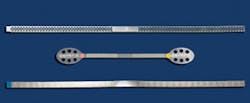Get excited with Gripstrip
By Michael DiTolla, DDS, FAGD
It would be impossible to practice modern adhesive dentistry without finishing strips, although I haven’t seen much to get excited about in the last few years.
Enter GripStrip (Fig. 1) from Centrix. Someone really smart at Centrix realized it would be much easier for us to use metal finishing strips with control if we had a better way to hold on to them. The perforated tabs at either end solve that problem.
When you look at the GripStrip, you will see much thought was put into the length of the strip. As a result, there is not an extra inch or two of strip dangling in the patient’s mouth.
Even when there is a free end in the patient’s mouth, it is the rounded outline of the thumb tab, and it will not cut or poke the patient. The thumb tabs enable you to hold the strip effectively. The GripStrip is worth buying because of this feature alone.
I have never really understood why existing finishing strips are as long as they are. Fig. 2 shows the length of a couple of popular finishing strips with the GripStrip in the middle. The typical finishing strip is just too long for my liking. I guess the point is to have plenty of strip available. But I seem to almost always gag the patient with the free end of the strip when it heads toward the throat.
The worst part is that, as you move toward the posterior region, the sharp edge of the unused portion of the strip threatens to cut the patient’s lip. In addition to the typical strip being too long, the corners at the end of the strips are also sharp and lack a safe end.
Fig. 3 shows the use of a GripStrip to recontour and smooth a direct composite. Since these contacts tend to be tight, the uncoated middle zone of the strip is the easiest to insert between the two teeth.
Once in, slide the strip to the 40-micron side (red) and finish the composite by curving it around the tooth to also polish the facial aspect. After finishing, use the 15-micron (yellow) side to polish the interproximal to ensure dental floss can pass freely through the contact.
The mundane world of proximal strips has had its first exciting breakthrough in a long time. I recommend you make GripStrip a part of your adhesive dentistry arsenal.
Michael DiTolla, DDS. FAGD, is the director of clinical research and education at Glidewell Laboratories in Newport Beach, Calif. He lectures nationwide on both restorative and cosmetic dentistry. Dr. DiTolla has several free clinical programs available online or on DVD at www.glidewelldental.com.
Past DE Issues



